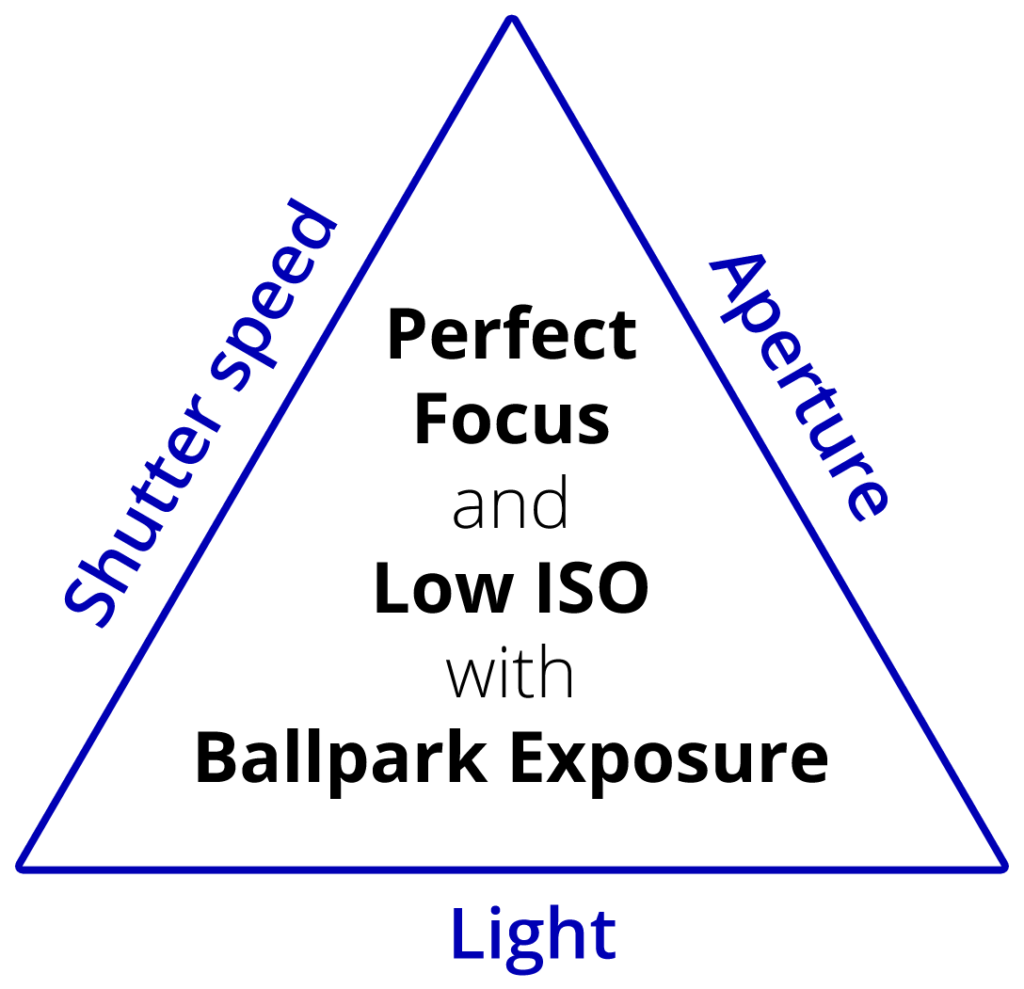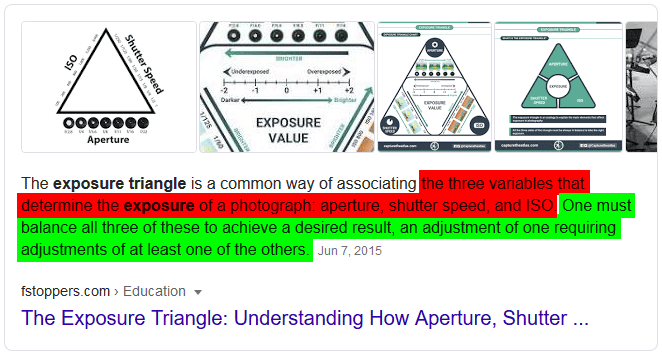The "Exposure Triangle" is a hoax
Every photographer has been told that in their quest for perfect photos, they must observe the so-called "Exposure Triangle" comprised of aperture, shutter speed and ISO. This is a myth. It was nonsense in the past, and it is still nonsense now. It’s time to end the hoax.

Let’s explore all the flaws …
1. FOCUS ISN’T MENTIONED, EVEN THOUGH IT’S CRUCIAL
This is so bizarre. Focus is the holy grail of every photo you take. If you miss the focus, it doesn’t matter how gorgeous the smile was, or how spectacular the sunrise was. Sure, a particularly stunning smile or sunrise might compel you to overlook flawed focus to a degree, but not a very large degree. If the focus is bad, the photo goes in the trash. End of story.
And yet we look at the triangle, and focus isn’t even mentioned! How can this be? It’s absurd.
Perhaps the photographic forefathers would claim that focus is implied. That is silly. Nobody ever wrote a basketball coaching handbook that didn’t mention shooting the ball through the hoop because it was "implied". Getting the ball through the hoop is front of mind for basketballers, and nailing perfect focus must be front of mind for photographers.
2. EXPOSURE ISN’T PARTICULARLY IMPORTANT
It’s the name of the triangle, but why? In this modern age of raw files, exposure is a mere nudge of a slider at your computer. It’s no more important or complicated than any other slider in your editing program. Exposure slider adjustments do come at a cost to file quality, but that cost is microscopically small in most cases.
Even in the film days, exposure was secondary to focus. So how did it get a legendary triangle named after it? Aperture and shutter speed have has much to do with focus as they do with exposure, so why did exposure get naming rights? It doesn’t make any sense. At the very least it should have been called the "Focus and Exposure Triangle".
But I don’t even think it deserves that. At a company board meeting, Exposure is no more important than the guy who serves the coffee. Coffee is nice, but it doesn’t make the big bucks.
When you’re shooting digital raw files, the exposure just needs to be "roughly okay". That’s all. A bit high or a bit low is no big deal.
3. ISO IS NOT A VARIABLE
The "triangle" is purported to represent three variables to control exposure. But in the film days ISO wasn’t very variable, was it? You had to choose the ISO of the film you loaded, and then you were stuck with that ISO. For as long as you had that roll in the camera, you didn’t have a triangle. It was an "Exposure Line" – just shutter speed and aperture.
Digital cameras give us the ability to change ISO for every photo if we went to. So this would lead you to think that ISO truly is a variable in modern photography. I don’t accept this notion. Even though ISO can be changed, doing so should be a last resort. ISO is not a setting to be adjusted carelessly. Higher ISO means poorer image quality. Higher ISO means more noise, and more noise means less clarity. Higher ISO means a less perfect image.
I’m aware that raising ISO is sometimes unavoidable, and I’m painfully aware of how little some photographers care about the fine-detail quality of their photos. Nonetheless, if there is such a thing as a perfect photo, the pursuit of it must involve low ISO for beautiful clean image data.
Remember that unlike Exposure, ISO cannot be corrected at your computer without visible cost to image quality. So we must never say that ISO is a "variable". Keeping ISO as low as possible is your goal.
So if ISO is not one of the variables, does that mean that there is no triangle? Is it just shutter speed and aperture after all? Hell no. There is a third variable, and it’s the most important one of all.
4. THE FORGOTTEN VARIABLE: LIGHT
This is the biggest, most astonishing error of all. The fallacy of the "Exposure Triangle" tries to convince us that the three camera settings exist to manage the light in your scene, as if light itself is beyond your control. This is SO wrong.
Light, I suggest, is the most important variable in photography, and controlling it should be your foremost consideration. Of course I realise there are some rare situations where you can’t control it – churches where flash is forbidden, for example, or heavy rain clouds on a day when the forecast said "clear and sunny". However there are a heck of a lot of ways you can control light. Flash and other lighting equipment; assistants holding reflectors or scrims; neutral density filters; choosing a different time of day; choosing a different location; turning on a light; opening a curtain; closing a curtain, turning your subject to face a different direction … so many ways you can adjust the light before it enters your lens.
Greater control of light gives you greater flexibility with the other variables. If the light in your scene is perfect, it frees your creativity with the other settings. Good light allows you to say "I’m going to capture the child jumping into Dad’s arms!". Poor light forces you to say "Scrap the jumping idea, I’ll never get my shutter speed fast enough."
I imagine most of you have never stopped to ponder this oversight before. You just accepted the flawed gospel. But now that you are pondering it, I’m sure you’ll agree it’s incomprehensible that light was left off the list of variables controlling film (and now pixel) exposure. What a farce.
THE REAL TRIANGLE
In reality, the triangle should look like this:

"The Perfect Focus and Low ISO with Ballpark Exposure Triangle" is a mouthful, and "PFLIBE Triangle" is gibberish, so for simplicity it should just be called "The Focus Triangle". But when it is being taught, photography students must be sure to understand that clean low-ISO pixel data is a crucial aspect of perfect focus.
So if you are teaching or mentoring, do the right thing. Abandon the confusing old myth, and impart true information.
HOW THE TRIANGLE WORKS
Let’s take another look at the first Google search result for "Exposure Triangle". The first statement (in red) is false. But the second statement (in green) is still perfectly true.

The principle of the triangle – that is, a three-part balancing act – remains valid. It’s all about balancing light, aperture and shutter speed for your perfect desired focus while maintaining the lowest possible ISO for the cleanest image data.
Remember that focus takes various forms. You might be focusing all the way from your subject to the horizon, or only on a few of your subject’s eyelashes. You might be freezing your subject mid-motion, or deliberately blurring their motion for artistic effect. So the concept of "perfect focus" differs from photo to photo. But every photo has its own perfect focus, and it is your number 1 goal.
If aperture (depth of field) is your priority, you must balance adequate light and appropriate shutter speed to nail your goal. If shutter speed (motion capture) is your priority, you balance light and aperture to achieve it. And if you are in a difficult situation where you can’t control the light, shutter speed and aperture must be juggled. In all cases, focus must be perfect, and exposure merely needs to be in the ballpark.
And ONLY in cases where the light is truly too dim, and you truly can’t improve it, should you raise ISO and sacrifice pixel quality. This is a last resort. Raising ISO is at best cheating, and at worst failing, in your pursuit of perfect photographs. You can do better. I believe in you.
